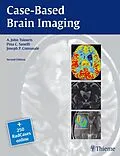Case-Based Brain Imaging, Second Edition, an update of the highly regarded Teaching Atlas of Brain Imaging, has full coverage of the latest technological advancements in brain imaging. It contains more than 150 cases that provide detailed discussion of the pathology, treatment, and prognosis of common and rare brain diseases, congenital/developmental malformations, cranial nerves, and more. This comprehensive case-based review of brain imaging will help radiologists, neurologists, and neurosurgeons in their training and daily practice.
Key Features:
- More than 1,000 updated high-resolution images created on state-of-the-art equipment
- Advanced CT and MR imaging introduces readers to current imaging modalities
- Pathological descriptions of radiologic diagnoses help clarify the pathophysiology of the disease
- Pearls and pitfalls of imaging interpretation for quick reference
- Authors are world-renowned brain imaging experts
Radiology residents, neuroradiology fellows preparing for board exams, and beginning practitioners will find this book an invaluable tool in learning how to correctly diagnose common and rare pathologies of the brain.
Autorentext
Associate Professor of Clinical Radiology, Weill Cornell Medical College, New York, NY, USA
Zusammenfassung
Case-Based Brain Imaging, Second Edition, an update of the highly regarded Teaching Atlas of Brain Imaging, has full coverage of the latest technological advancements in brain imaging. It contains more than 150 cases that provide detailed discussion of the pathology, treatment, and prognosis of common and rare brain diseases, congenital/developmental malformations, cranial nerves, and more. This comprehensive case-based review of brain imaging will help radiologists, neurologists, and neurosurgeons in their training and daily practice.
Key Features:
- More than 1,000 updated high-resolution images created on state-of-the-art equipment
- Advanced CT and MR imaging introduces readers to current imaging modalities
- Pathological descriptions of radiologic diagnoses help clarify the pathophysiology of the disease
- Pearls and pitfalls of imaging interpretation for quick reference
- Authors are world-renowned brain imaging experts
Radiology residents, neuroradiology fellows preparing for board exams, and beginning practitioners will find this book an invaluable tool in learning how to correctly diagnose common and rare pathologies of the brain.
Inhalt
<p><strong>Section I. Neoplasms</strong><br><strong><em>IA. Supratentorial</em></strong><br>Case 1 Low-grade Astrocytoma (WHO Grade II)<br>Case 2 Anaplastic Astrocytoma (WHO Grade III)<br>Case 3 Glioblastoma Multiforme (WHO Grade IV)<br>Case 4 Oligodendroglioma (WHO Grade II or III)<br>Case 5 Central Neurocytoma (WHO Grade II)<br>Case 6 Ganglioglioma (WHO Grade I&–III)<br>Case 7 Gliomatosis Cerebri (WHO Grade IV)<br>Case 8 Metastatic Breast Cancer<br>Case 9 Dural Metastasis from Stage IV Breast Cancer<br>Case 10 Lymphomatous Meningitis<br>Case 11 Primary CNS Lymphoma<br>Case 12 Dysembryoplastic Neuroepithelial Tumor (WHO Grade I)<br>Case 13 Ependymoblastoma (WHO Grade IV)<br>Case 14 Pineocytoma (WHO Grade I)<br>Case 15 Pineoblastoma (WHO Grade IV)<br>Case 16 Pineal Region Germinoma<br>Case 17 Pituitary Microadenoma (WHO Grade I)<br>Case 18 Pituitary Macroadenoma<br>Case 19 Rathke Cleft Cyst<br>Case 20 Craniopharyngioma (WHO Grade I)<br>Case 21 Meningioma (WHO Grade I)<br>Case 22 Subependymoma of Fourth Ventricle (WHO Grade I)<br>Case 23 Choroid Plexus Papilloma (WHO Grade I)<br>Case 24 Arachnoid Cyst<br>Case 25 Dermoid Cyst<br>Case 26 Mature Pineal Teratoma<br>Case 27 Colloid Cyst<br>Case 28 Neurenteric Cyst<br>Case 29 Lipoma<br>Case 30 Psammomatoid Ossifying Fibroma<br><strong><em>IB. Infratentorial</em></strong><br>Case 31 Juvenile Pilocytic Astrocytoma (WHO Grade I)<br>Case 32 Tectal Glioma (WHO Grade I or II)<br>Case 33 Brainstem Glioma<br>Case 34 Medulloblastoma (WHO Grade IV)<br>Case 35 Ependymoma (WHO Grade II or III)<br>Case 36 Vestibular Schwannoma (WHO Grade I)<br>Case 37 Epidermoid Cyst<br><strong>Section II. Inflammatory Diseases</strong><br><strong><em>IIA. Infectious</em></strong><br>Case 38 Herpes Simplex Virus Type I<br>Case 39 Bacterial Meningitis<br>Case 40 Acute Cerebellitis<br>Case 41 Brain Abscess<br>Case 42 Subdural Empyema<br>Case 43 Neurocysticercosis<br>Case 44 Tuberculosis Meningitis<br>Case 45 Fungal (Aspergillosis) Abscess<br>Case 46 HIV Encephalitis<br>Case 47 Progressive Multifocal Leukoencephalopathy<br>Case 48 CNS Toxoplasmosis<br>Case 49 Cryptococcal Meningitis<br><strong><em>IIB. Non-Infectious</em></strong><br>Case 50 Systemic Lupus Erythematosus<br>Case 51 Langerhans Cell Histiocytosis<br>Case 52 Mesial Temporal Sclerosis<br>Case 53 Neurosarcoidosis<br>Case 54 Lymphocytic Hypophysitis<br>Case 55 Intracranial Hypotension<br><strong>Section III. Cerebrovascular Diseases</strong><br>Case 56 Aneurysmal Subarachnoid Hemorrhage<br>Case 57 Giant Aneurysm<br>Case 58 Mycotic Aneurysm<br>Case 59 Perimesencephalic Nonaneurysmal Subarachnoid Hemorrhage<br>Case 60 Middle Cerebral Artery Embolus and Acute Infarction<br>Case 61 Watershed Injury<br>Case 62 Basilar Artery Thrombosis<br>Case 63 Arterial Dissection<br>Case 64 Hypertensive Hemorrhage<br>Case 65 Global Anoxic Brain Injury<br>Case 66 Cavernous Malformation&a...
